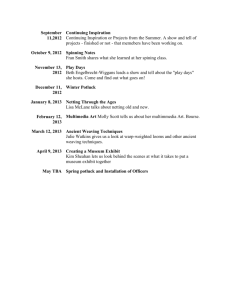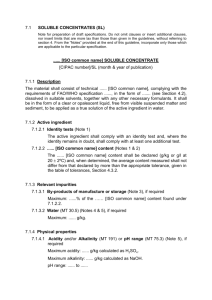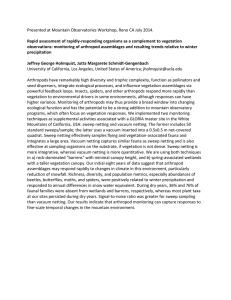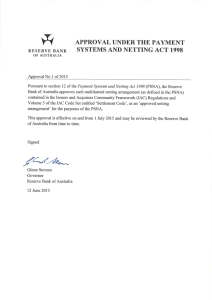LONG-LASTING INSECTICIDAL NETS OR NETTING (LN) INTRODUCTION
advertisement
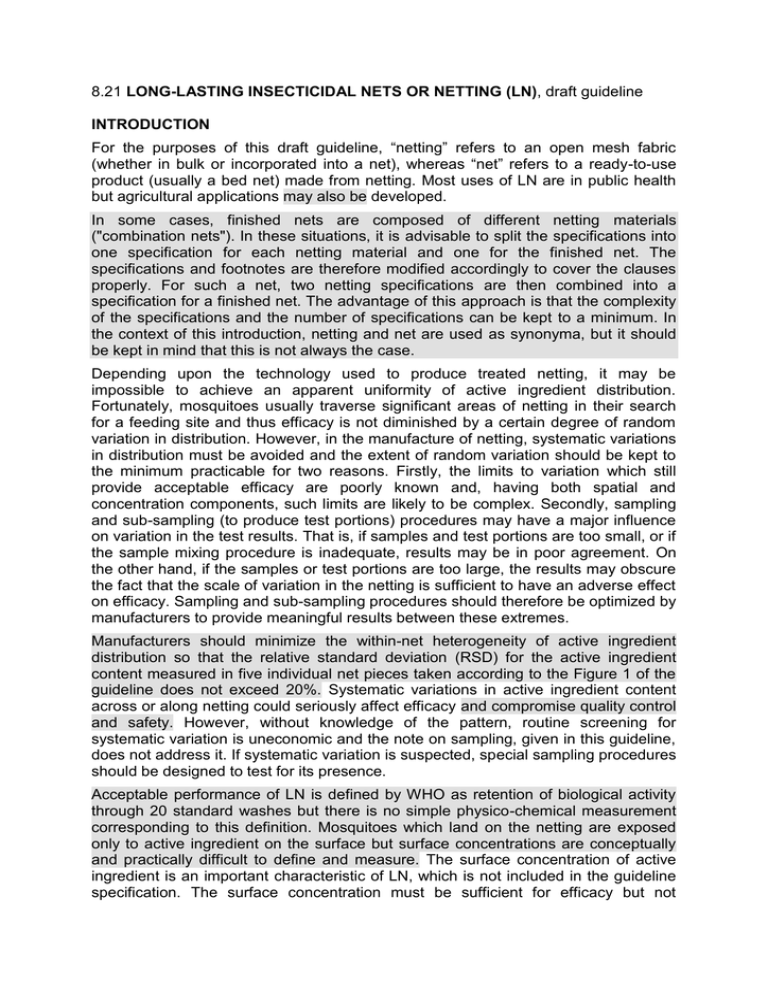
8.21 LONG-LASTING INSECTICIDAL NETS OR NETTING (LN), draft guideline INTRODUCTION For the purposes of this draft guideline, “netting” refers to an open mesh fabric (whether in bulk or incorporated into a net), whereas “net” refers to a ready-to-use product (usually a bed net) made from netting. Most uses of LN are in public health but agricultural applications may also be developed. In some cases, finished nets are composed of different netting materials ("combination nets"). In these situations, it is advisable to split the specifications into one specification for each netting material and one for the finished net. The specifications and footnotes are therefore modified accordingly to cover the clauses properly. For such a net, two netting specifications are then combined into a specification for a finished net. The advantage of this approach is that the complexity of the specifications and the number of specifications can be kept to a minimum. In the context of this introduction, netting and net are used as synonyma, but it should be kept in mind that this is not always the case. Depending upon the technology used to produce treated netting, it may be impossible to achieve an apparent uniformity of active ingredient distribution. Fortunately, mosquitoes usually traverse significant areas of netting in their search for a feeding site and thus efficacy is not diminished by a certain degree of random variation in distribution. However, in the manufacture of netting, systematic variations in distribution must be avoided and the extent of random variation should be kept to the minimum practicable for two reasons. Firstly, the limits to variation which still provide acceptable efficacy are poorly known and, having both spatial and concentration components, such limits are likely to be complex. Secondly, sampling and sub-sampling (to produce test portions) procedures may have a major influence on variation in the test results. That is, if samples and test portions are too small, or if the sample mixing procedure is inadequate, results may be in poor agreement. On the other hand, if the samples or test portions are too large, the results may obscure the fact that the scale of variation in the netting is sufficient to have an adverse effect on efficacy. Sampling and sub-sampling procedures should therefore be optimized by manufacturers to provide meaningful results between these extremes. Manufacturers should minimize the within-net heterogeneity of active ingredient distribution so that the relative standard deviation (RSD) for the active ingredient content measured in five individual net pieces taken according to the Figure 1 of the guideline does not exceed 20%. Systematic variations in active ingredient content across or along netting could seriously affect efficacy and compromise quality control and safety. However, without knowledge of the pattern, routine screening for systematic variation is uneconomic and the note on sampling, given in this guideline, does not address it. If systematic variation is suspected, special sampling procedures should be designed to test for its presence. Acceptable performance of LN is defined by WHO as retention of biological activity through 20 standard washes but there is no simple physico-chemical measurement corresponding to this definition. Mosquitoes which land on the netting are exposed only to active ingredient on the surface but surface concentrations are conceptually and practically difficult to define and measure. The surface concentration of active ingredient is an important characteristic of LN, which is not included in the guideline specification. The surface concentration must be sufficient for efficacy but not excessive, to avoid unacceptable exposure of users to the active ingredient, or unacceptable losses of active ingredient by washing/weathering. However, interpretation of measurements of surface concentration is problematic. Firstly, because the “surface” from which active ingredient is removed is highly dependent upon the extraction method and conditions. Secondly, because the distribution of at least a proportion of the active ingredient is in dynamic equilibrium within and on the LN. The distribution may be influenced by current conditions or the history of conditions in which the netting is/was stored, depending upon whether equilibrium is reached rapidly or slowly. Surface concentration may be used as a quality control criterion by manufacturers during the production of nets but it is too variable to be a useful thereafter. Control of mosquitoes (measured as mortality or knock-down) appears to decline from good to poor within very narrow ranges of surface concentration, with the critical ranges for change evidently differing between, and possibly within, products. These differences may be due to variations in spatial presentation and/or distribution of active ingredient, and possibly other factors, but any particular value for surface concentration does not correspond to a specific level of biological response. Consequently, there is no point in trying to develop highly accurate and precise analytical test methods to measure/estimate surface concentrations after 20 washes, nor to use them to develop limits for WHO specifications. WHO specifications should provide limits and methods giving an indication of whether or not some retention/release actually occurs but they cannot be used to prove that a particular net will provide acceptable efficacy, before or after 20 standard washes. CIPAC (2010) is currently developing a method to determine the retention or release index of active ingredient for LN. This method is based on the measurement of the wash resistance and is a standardisation of the WHO washing method published in the “WHO Guidelines for laboratory and field testing of long-lasting insecticidal mosquito nets”, document WHO/CDS/WHOPES/GCDPP/2005.11, World Health Organization, Geneva, 2005. Until this method is standardized, finalized and adopted by CIPAC, the specifications for LN will be published as interim specifications. The clause for bursting strength provides indirect control of the mass of net/m2. Note for preparation of draft specifications. Do not omit clauses or insert additional clauses, nor insert limits that are more lax than those than given in the guidelines, without referring to Section 4. If two or more active ingredients are co-formulated, they should have separate specifications, except in some cases where special controls are required. For combination LN, specifications must be separated into one specification for each netting material and one for the finished net. From the “Notes” provided at the end of this guideline, incorporate only those which are applicable to the particular specification. …[ISO common name] LONG-LASTING INSECTICIDAL NET OR NETTING (Note 1) [CIPAC number]/LN (month & year of publication) 8.21.1 Description (Note 1) The product shall be formed from (or in the form of) netting, consisting of …..[denier ‡, mono-/multi-filament, polymer type] fibres, treated with/incorporating, technical/formulated …..[ISO common name] complying with the requirements of FAO/WHO specification ….[CIPAC number/technical or formulation code (date)], and …..[ISO common name] (synergist, if required) complying with the requirements of FAO/WHO specification ….[CIPAC number/technical or formulation code (date)], together with any necessary ‡other formulants (Note 2), and synergist, if required. The product shall appear clean and shall be free from visible extraneous matter (Note 3), visible damage (such as splitting or tearing) and visible manufacturing defects (such as poorly made seams or a weave that is either not uniform or too loose to remain uniform in use), and shall be suitable for use as/in an insecticidal net with long-lasting activity (Notes 4 & 5). 8.21.2 Active ingredient 8.21.2.1 Identity tests (Note 6) The active ingredient (and synergist, if required) shall (each) comply with an identity test and, where the identity remains in doubt, shall comply with at least one additional test. 8.21.2.2 Content of active ingredient (Notes 6, 7 and 8) The …[ISO common name] content shall be declared ( ‡…g/kg ‡) and, when determined, the average content shall not differ from that declared by more than the appropriate value given in the table of tolerances, Section 4.3.2. 8.21.2.3 Isomer ratio (Notes 6 & 9), if required The ratio of … isomers shall be in the range … to …. 8.21.2.4 Retention/release index of active ingredient (Notes 7 & 10) The retention/release index of …[ISO common name] from the netting, when determined, shall be within the range … to …. 8.21.2.5 Content of synergist (Notes 6, 7, 8, 9 & 11), if required The …[common name and/or chemical name and CAS number of synergist] content shall be declared (‡ …g/kg ‡) and, when determined, the average content shall not differ from that declared by more than the appropriate value given in the table of tolerances, Section 4.3.2. 8.21.2.6 Retention/release index of synergist (Notes 7 & 10) The retention/release index of …[ISO common name] from the netting, when determined, shall be within the range … to …. 8.21.3 Relevant impurities 8.21.3.1 By-products of manufacture or storage (Notes 7, 9 & 11), if required Maximum: …% of the …[ISO common name of active ingredient] content found under 8.21.2.2. 8.21.4 Physical properties 8.21.4.1 Netting mesh size (Note 7) When counted by the method given in Note 12, the average number of complete holes/cm2 shall be not less than … and the lowest value shall be not less than …. 8.21.4.2 Dimensional stability of netting to washing (Notes 7 & 13) Not more than 5% shrinkage/expansion in both dimensions. 8.21.4.3 Bursting strength (Notes 7 & 14) The minimum bursting strength of the fabric shall be declared (not less than ‡…. kPa) and, when determined, the average shall be not less than that declared. If seams are present, their average bursting strength shall be not less than the average for the fabric. 8.21.5 Storage stability 8.21.5.1 Stability at elevated temperature (MT 46.3) After storage at 54 2°C for 2 weeks (Note 15), the determined total active ingredient content shall not be lower than …..%, and the determined total synergist content shall not be lower than …. % (Note 9), relative to the determined average content found before storage (Note 16) and the product shall continue to comply with the clauses for: - isomer ratio (8.21.2.3), if required, - retention or release index (8.21.2.4 and 8.21.2.6) (Note 17), - by-products of manufacture or storage (8.21.3.1) (Note 18), - dimensional stability (8.21.4.2), - bursting strength (8.21.4.3). _________________________________ Note 1 The specification may apply to manufactured nets only, to bulk netting only or to both, as required. The title and description clause should be modified accordingly. Note 2 If a particular UV-stabilizer or other adjuvant is essential, its identity and minimum concentration should be given in a Note, together with details of a validated analytical method. If appropriate, the maximum concentration may also be stated. Note 3 Occasional short lengths of loose thread present in the netting are not considered to be extraneous matter. Note 4 Long-lasting insecticidal netting is expected to retain its insecticidal activity during its lifespan and through a number of washes (public health products) or in worst-case expected climatic conditions (agricultural products). Note 5 Flammability of the product is not part of the specification but it should be measured by the manufacturer, according to 16CFR Part 1610, and the result presented on the package. The linear density (denier) of the fibres cannot be measured in the manufactured net, but should be identified on the packaging. Note 6 Method(s) of analysis must be CIPAC, AOAC or equivalent. If the methods have not yet been published then full details, with appropriate method validation data, must be submitted to FAO/WHO by the proposer. ‡ Note 7 Samples should be taken according to Figure 1 or on a convenient diagonal across the width of bulk material. Samples must be sufficiently large to conduct all tests required and representative of the net or netting. Except where seams are to be tested, do not test material within 10 cm of seams or selvedges. Where a final product is made from more than one type of netting, each type of netting should be sampled and tested separately. Use sharp scissors, or equivalent, to minimize damage to the fibres and fabric and thus avoid any consequential bias in the results of certain tests. Roll up the strips or squares and place them in labelled, new, clean aluminium foil prior to analysis. Samples should be kept cool, avoiding heat sources (including sun heat) or freezing, and analyzed/tested with minimum delay. Representative portions (sub-samples) for testing should be taken as described in each test method. For the purposes of chemical analysis, the analytical method and the number and size of test portions analyzed should be designed to provide results with a relative standard deviation (RSD) ≤5%. Test portion and replication requirements for physical test methods are defined in the methods or Notes referenced. Note 8 For coated LN, if the netting is manufactured under different denier, the active ingredient (and synergist) content has to be specified for each type of denier. If the active ingredient content is also specified as mg/m2 of netting, this should be calculated from values for active ingredient in g/kg and mass of net/m 2. Mass of net/m 2 should be determined according to ISO 3801 (1977). In cases of dispute, g/kg values shall be used. Note 9 This clause or sub-clause is required only if appropriate to the product specified. Isomer ratio is specified only where the active ingredient is defined as a particular isomer ratio. A synergist is specified only where required. ‡ An impurity is specified only where it is relevant, as defined in the glossary of terms (Appendix C) . Note 10 Currently (2010), CIPAC is developing a wash method for determination of the retention behaviour of long-lasting insecticidal mosquito nets. Prior to the publication in a Handbook, copies of the method may be obtained through the CIPAC website, http://www.cipac.org. This method is a standardisation of the WHO washing method published in the “WHO Guidelines for laboratory and field testing of long-lasting insecticidal mosquito nets”, document WHO/CDS/ WHOPES/GCDPP/2005.11, World Health Organization, Geneva, 2005. Briefly, the retention index is determined by analyzing net samples in triplicate representing wash points 0 and 4 for total active ingredient content and calculating the average retention index per wash using the equation for a free migration stage behaviour. A retention index per wash of 0.95 indicates that at least 95 % of the insecticide present in samples washed 1 to 3 times is still present after an additional wash step. The retention index applies to the average obtained from triplicate tests performed on samples removed side by side in the length direction from the same net or batch of netting ‡ Note 11 The method of analysis must be peer-validated, as a minimum. If it is not published, full details of the method and the peer-validation data must be provided. Note 12 In the absence of a simple or standard method to determine the size of holes, which may have complex shapes, in highly flexible fabrics, mesh size is determined by counting the number of holes in a square of the fabric. Counting may be done directly on the fabric or indirectly by taking a picture/photocopy of the fabric. Indirect methods may ease counting and provide a permanent record. Before counting, the fabric should be conditioned according to ISO 139 (1973) (4 h, 20ºC, 65% relative humidity). Use a template to define the square of netting, taking care not to stretch or distort the fabric. The template should be a 1-2 mm thick rigid sheet, in/on which an accurately calibrated (±1% in each dimension) square (e.g. 1 x 1 in or 5 x 5 cm) has been cut/marked. If a template is not available and a ruler must be used, great care is required to ensure that the area counted is square. Where practicable, one edge of the square to be counted should be aligned with a row of complete holes in the fabric. Incomplete holes ≥½ are counted as complete holes, whereas those <½ are not counted. Count 5 replicate squares selected according to Note 7, calculate the average and note the lowest value. Note 13 Method of preparation, marking and measuring: ISO 3759 (2007 ‡ ). Method of washing: ISO 6330 (2001). Method of calculation: ISO 5077 (1984). Size of test portions: 500 mm x 500 mm; mark off 350 mm x 350 mm within each test portion. Test a total of 4 replicate portions, 2 washed in each of 2 separate loads. Type of washing machine: ISO type A (front loading). Washing programme: ISO type 8A (gentle cycle 30ºC). Fill the washer with dummy load (with fabric as per ISO standard) up to the standard of 2 to 4 kg. Drying: flat drying. Note 14 Test method: ISO 13938 part 1 (1999) and ISO 13938 part 2 (1999), with conditioning of the fabric as specified in the ISO standard. The declared minimum bursting strength, and testing for compliance with it, should be based on tests of 7.3 cm 2 areas of fabric. Proposed specifications based on tests of 50 cm2 area must be supported by data showing the suitability of the proposed value and its relationship to minimum of 250 kPa (which is based on 7.3 cm2 area). Five replicate tests should be conducted on samples taken at approximately equal distances on a diagonal across the netting, taking no sample within 10 cm of a border or seam. In made up rectangular nets, the “diagonal” may correspond to one produced by conceptually arranging the panels end to end). The average of the 5 measurements is calculated. The method to test seam bursting strength is identical to that used to test the fabric, except that 5 replicate tests should be made, with the seam centred on the test head. Up to 5 seams may be tested but, if there are <5 seams, replicate measurements should be made on 1 or more seams, to provide a total of 5 measurements. Note 15 Unless other temperatures and times are specified. Refer to Section 4.6.2 for alternative storage conditions. Note 16 Samples of the product taken before and after the storage stability test should be analyzed concurrently in order to reduce the analytical error. Note 17 If justified by the supporting data, an increase or decrease in the limit(s) applying after the storage stability test may be specified in the sub-clause. Note 18 This sub-clause is required only if the relevant impurity concentration is capable of increasing during storage. Figure 1 Recommended positions from which 5 pieces of netting should be taken from a made up bed net and combined to form a representative sample. Rectangular net 4 3 5 Side-panels 1 2 5 4 2 1 Roof panel 3 Conical net 5 4 3 2 1
